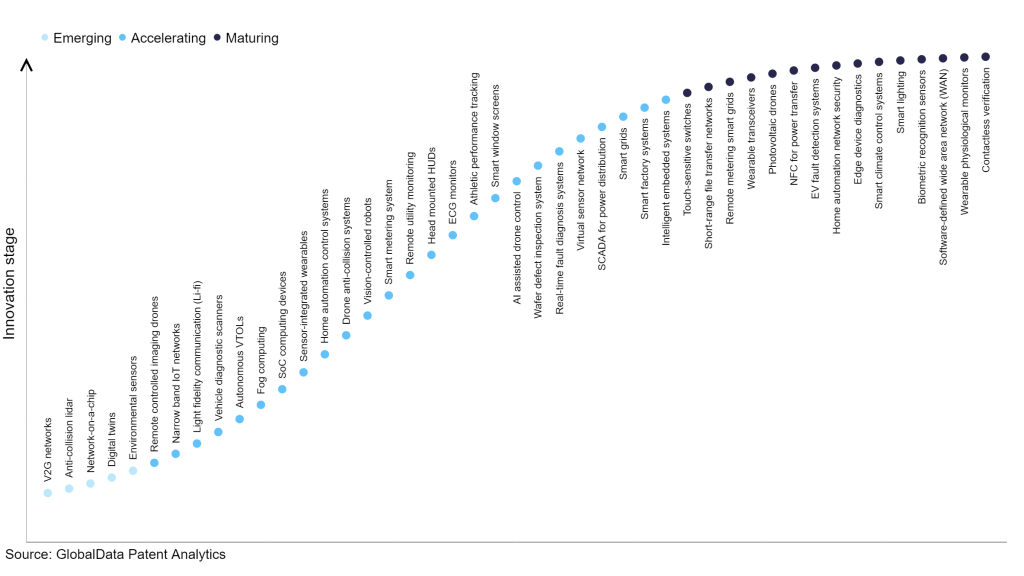The technology sector remains a hub of innovative activity, primarily fuelled by the convergence of technological progress, heightened connectivity, and the necessity for companies to enhance efficiency and competitiveness in a swiftly transforming marketplace, as well as growing importance of technologies such as narrowband radio frequency, low power wide area technology, long range communication, and enhanced coverage and penetration. These technologies collectively enable narrow band IoT networks to provide long-range, low-power, and cost-effective connectivity for a wide range of IoT applications. In the last three years alone, there have been over 3.6 million patents filed and granted in the technology industry, according to GlobalData’s report on Innovation in Internet of Things: Narrow band IoT networks. Buy the report here.
However, not all innovations are equal and nor do they follow a constant upward trend. Instead, their evolution takes the form of an S-shaped curve that reflects their typical lifecycle from early emergence to accelerating adoption, before finally stabilising and reaching maturity.
Identifying where a particular innovation is on this journey, especially those that are in the emerging and accelerating stages, is essential for understanding their current level of adoption and the likely future trajectory and impact they will have.
300+ innovations will shape the technology industry
According to GlobalData’s Technology Foresights, which plots the S-curve for the technology industry using innovation intensity models built on over 2.5 million patents, there are 300+ innovation areas that will shape the future of the industry.
Within the emerging innovation stage, environmental sensors, digital twins, and network-on-a-chip are disruptive technologies that are in the early stages of application and should be tracked closely. Intelligent embedded systems, smart factory systems and smart grids are some of the accelerating innovation areas, where adoption has been steadily increasing. Among maturing innovation areas are, contactless verification, wearable physiological monitors, and software-defined wide area network, which are now well established in the industry.
Innovation S-curve for IoT in the technology industry

Narrow band IoT networks is a key innovation area in IoT
Narrow band Internet of Things (NB-IoT) networks are cellular networks created specifically to cater to low-power IoT devices. These networks offer cost-effective and energy-efficient wide area communication (LPWAN) with enhanced coverage in demanding surroundings and increased capacity in densely populated urban areas. NB-IoT networks employ a narrow band radio connection to establish secure, dependable, power-efficient, and affordable connections over extended distances. They operate within licensed frequency bands, often using sub-GHz frequencies, and are commonly utilised for extensive deployments.
GlobalData’s analysis also uncovers the companies at the forefront of each innovation area and assesses the potential reach and impact of their patenting activity across different applications and geographies. According to GlobalData, there are 70+ companies, spanning technology vendors, established technology companies, and up-and-coming start-ups engaged in the development and application of narrow band IoT networks.
Key players in narrow band IoT networks – a disruptive innovation in the technology industry
‘Application diversity’ measures the number of different applications identified for each relevant patent and broadly splits companies into either ‘niche’ or ‘diversified’ innovators.
‘Geographic reach’ refers to the number of different countries each relevant patent is registered in and reflects the breadth of geographic application intended, ranging from ‘global’ to ‘local’.
Patent volumes related to narrow band IoT networks
Source: GlobalData Patent Analytics
Intel is one of the leading patent filers in narrow band IoT networks. The company’s patents are aimed at embodiments of an enhanced Node B (eNB) and method to provide system information (SI) updates to user equipment (UE) in sleep or idle mode with an extending paging cycle.
In some embodiments, a paging message is configured to include an optional field to indicate whether there has been any SI update since a last paging occasion for a UE in sleep or idle mode with an extending paging cycle. SI updates are transmitted by the eNB during a system information modification period that is shorter than a period extending paging cycle. The optional field may indicate whether or not the UE is to acquire the latest SI update during the current paging occasion.
Other prominent patent filers in the space include LG and Apple.
By geographic reach, Neul leads the pack, followed by Webb William and Intel. In terms of application diversity, adidas holds the top position, followed by Casio Computer and Network-1 Technologies.
NB-IoT networks can provide low-power, wide area connectivity for IoT devices with extended coverage and reliable communication in a cost-effective manner. These networks enable diverse IoT applications, ranging from smart cities and agriculture to industrial automation and healthcare, fostering the growth and development of the IoT ecosystem.
To further understand how IoT is disrupting the technology industry, access GlobalData’s latest thematic research report on Internet of Things – Thematic Research.
Data Insights
From

The gold standard of business intelligence.
Blending expert knowledge with cutting-edge technology, GlobalData’s unrivalled proprietary data will enable you to decode what’s happening in your market. You can make better informed decisions and gain a future-proof advantage over your competitors.







